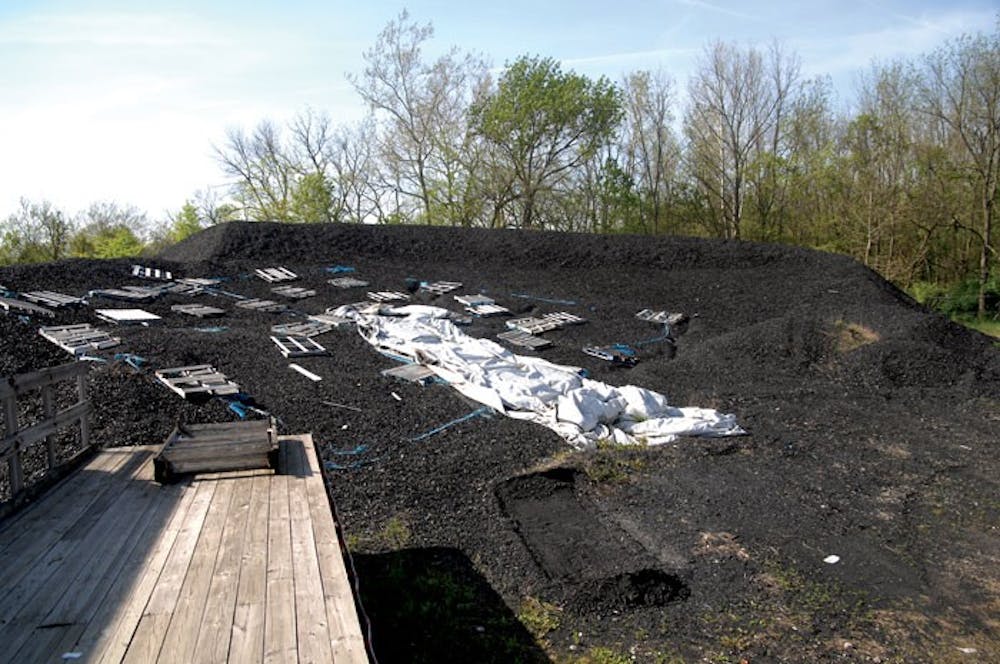
A pile of coal located off OH-73 sits at the Materials Recover Facility and may be harmful. (SAMANTHA LUDINGTON | The Miami Student)
Most students have never visited the Materials Recovery Facility (MRF).
Located off of OH-73 just past the rugby fields, it is where plastic bottles, glass, paper and aluminum cans are sent to be given new purpose in a new form. But not everything that arrives at the MRF moves on to new use.
Some materials, such as a 4,000-ton pile of coal that has been on the site for at least 34 years, could be harmful to the environment, according to the Southwest District Office of the Ohio Environmental Protection Agency (EPA).
Cody Powell, director of building maintenance, said the pile was initially three times its current size and was intended to be a hedge against unanticipated interruptions of the coal supply to Miami's steam plant used to provide building heat, water heat and support food cooking.
"The university is trying to protect its best interest to make sure it has a quantity of coal on hand to handle any situation to protect the campus and its operations," Powell said.
Powell said the pile has gradually been allowed to shrink because new fuel options — such as natural gas or fuel oil — could allow operations to continue at the steam plant in an emergency.
Powell said the university may use the pile again sometime within the next several months to avoid paying premium coal prices while negotiations for a new coal contract take place.
Powell is not sure precisely how long the coal has been at the MRF.
"My longest tenured employee in utilities started in 1976 and the storage pile was here at that time," Powell said. "The last time he recalled using any quantity from this pile was in the 1980's."
The pile's original 12,000 tons would have sustained the university for a year when it was initially created.
Enjoy what you're reading?
Signup for our newsletter
Powell said the university now uses 22,000 tons of coal a year; the 4,000-ton pile could now only sustain the university for a month or two.
Much else has changed since the coal pile first appeared at the MRF. If the pile were formed prior to 1970, for instance, it would predate the EPA. It predates the most recent version of Ohio law dealing with water pollution control — which took effect in March 2000 — by at least 24 years.
With the pile now being prepared for use by the university, new attention is being paid to what the university is, could or should be doing to minimize air and water pollution from the pile.
Bonnie Pray, a compliance specialist with the Hamilton County Environmental Services, said Miami has the necessary air related permit for the pile. Pray said inherent moisture — such as humidity and rain — keeps static piles like Miami's from causing significant air pollution. But Pray explained the same factors could cause water pollution.
"Runoff is probably the bigger issue," Pray said. "It gets into surface waters."
Mike Proffitt of the Groundwater Division of the Southwest District of the Ohio EPA said poly-aromatic hydrocarbons (PAHs) have the potential to leech out of coal and accumulate in stream sediments. It is possible the coal pile is polluting surface waters, groundwater or both. In either case, Proffitt said testing is needed to determine whether a water permit is necessary.
"If the coal pile was not running off to surface water but was reaching the aquifer, it would be a violation and they would have to do something about it," Proffitt said. "You cannot have an unpermitted discharge to a water of the state."
Powell said he is not sure what is under the pile. The pile is also mostly uncovered; an attempt several years ago to cover the pile with wooden pallets and carts was never carried out to completion. The less containment there is around the pile, the greater the potential there is for runoff infiltrating the surrounding environment.
Chris Cotton of the Water Quality Division of the Southwest District of the Ohio EPA said Miami should consider taking steps to better contain the pile.
"The university would be smart to pay attention to it," Cotton said. "If there is a potentially usable aquifer underneath where the coal is stored, they'd be setting themselves up for some major problems."
Powell said the coal — which comes from the ground — won't pollute the ground. Cotton said rainwater, which is naturally slightly acidic, could leech certain components out of the unprotected coal, including dangerous heavy metals.
"I think it's probably wishful thinking to think there's no impact," Cotton said. "It would be a matter of taking samples. They might be surprised to find out what's happened given all the time its been sitting out there."
Cotton said the coal pile, located several hundred feet from Harker's Run — and uphill from it — could very well be polluting surface or ground waters.
Sophomore Alyssa Ferraro, who visited the MRF with a class and saw the coal pile, said she would like the university to pay more attention to potential problems stemming from the pile.
"Nobody seems to have thought about it in a long time," Ferraro said. "I feel like it could rain and dissolve and run off into things it shouldn't run off into or get absorbed into groundwater because it's just sitting there with no protection at all."
Powell said Miami is eager to be environmentally proactive.
"We've got nothing to hide," Powell said. "We're a state institution and we do our very best to protect the environment."




